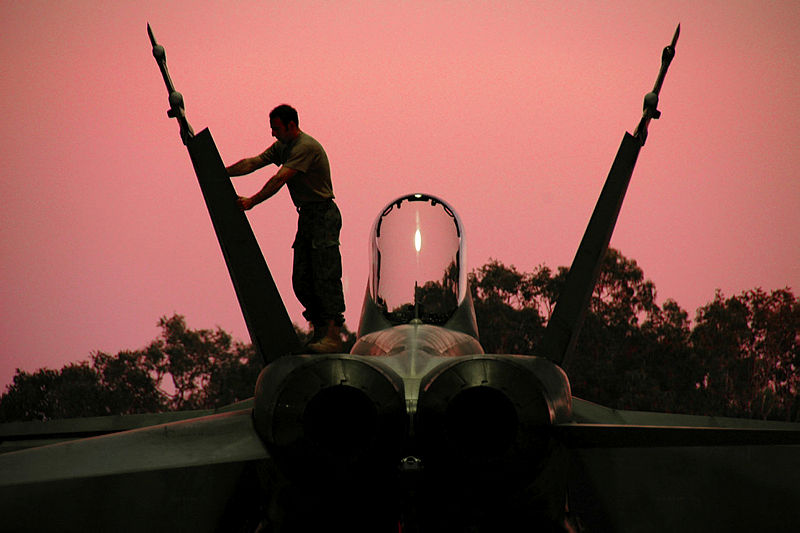
There’s a constant in Australian defence: not enough people. In peacetime, the defence organisation’s difficulties with recruitment are an ongoing saga, occasionally surfacing in headlines like ‘Sailor shortage strands Australian warship HMAS Perth in dry dock for two years’. With less drama, ASPI’s Marcus Hellyer revealed real problems reaching workforce objectives; since 2016, the number of Australian Defence Force personnel has risen by only 600 against a target of 1,730.
In wartime, it’s even worse. In both world wars, Australia’s defence workforce reached capacity. At the end of the day, Australia has a small population, yet it has big ambitions and wants to punch above its weight. Constraints from a workforce of limited size are inevitable.
It may get worse. Australia is a small country living in, as Coral Bell termed it, a neighbourhood of giants. Unexpected events can make it smaller, as happened with the pandemic and the government’s call to temporary visa holders to leave. Hundreds of thousands who were in the workforce at the start of 2020 have left and it’s been suggested that about 600,000 will be gone by year’s end.
An former immigration official recently said, ‘We could be on the verge of the biggest percentage and absolute decline in our population since 1788’. It may take years to get back to the population size Australia had four months ago. All of this will accelerate the demographic ageing of Australia’s overall workforce. The pool of younger people the ADF can recruit from will become even smaller.
These developments will not help Defence with its workforce issues, in peace or war. A smaller Australian workforce affects all sectors. None will be immune.
One way to do more with fewer people is to automate, and today that means digital transformation. High-tech systems are now embedded in Australia’s major port facilities, supermarket chains, mail distribution centres, construction industry services and even our homes. A recent study of the mining industry predicts that the application of digital technology over the next decade will occur in three stages.
Mining companies’ use of automation today involves individual, non-interoperable, semi-autonomous vehicles. By 2025, mines will feature smart sensors, autonomous vehicles, limited self-learning systems and some pieces of equipment that will operate together. From 2030, autonomous machines will work in mines with other such machines to complete tasks.
Open-source platforms will integrate readily with similar equipment, allowing machine-to-machine communications and real-time data exchange so they self-learn and can make decisions. Mining companies are doing this with large productivity gains. If they can do so, why can’t Defence?
Mines are fixed sites, but Defence has many bases that offer similar opportunities. The most obvious are airbases.
My recent paper published by the Air Power Development Centre, Surfing the digital wave: engineers, logisticians and the future automated airbase, goes into this possibility in detail. The range of commercial technologies that airbases may employ includes artificial intelligence, digital twins, big data, cloud computing, the internet of things, autonomous operations and robotics, 3D printing and human augmentation. Digitally transformed airbases could generate more aircraft sorties, faster, with considerably fewer people than now.
Robot turns of serviceable aircraft, including refuelling and weapons loading, could be possible. Predictive maintenance using artificial intelligence would make unscheduled maintenance rare, or at least uncommon. Real-time stock tracking would ease logistics, while 3D printing means airbases might resupply themselves with some items.
Airbases would appear uninhabited, with personnel at central control centres managing engineering and logistics tasks both there and at remote airbases. Bases might even generate their own power to become semi-self-sufficient.
This wouldn’t be just for southern main bases. Automation as a concept is equally applicable to Australia’s northern bare bases. Fewer people would be needed to activate them if the robots were already there, just waiting to be switched on. Offshore airbases may need air-transportable automation to go ‘live’ but, technically, that seems doable.
Notions of generating more airpower using fewer people draw inspiration from the Israeli Air Force’s first day of the Six-Day War. The IAF had only about 200 combat aircraft but flew 1,000 sorties. The crucial step was to emphasise very rapid aircraft turnarounds. Generating more sorties gave a virtual, if not literal, increase in air combat fleet size. Automated airbases could bring this step-up to Australian airpower.
If mines, other industry sectors and, potentially, airbases can be digitally transformed, that suggests that many other ADF fixed bases could be as well. Airbases could lead the way.
Keeping up with the rest of Australian society is not necessarily a good argument for the ADF embracing digital disruption. However, unless it does, by 2030 its fixed bases may be lonely outposts of 20th-century technology in a 21st-century world.
The capabilities of the digitally transformed national support base would then need to be dumbed down when engaged on ADF bases. If such incompatibilities arise, the ADF won’t get the full benefits from the fourth industrial revolution. Technological stagnation would have a price.
Events over the past few months make digital transformation even more important. A post-pandemic Australia with a smaller national workforce would increase the pressure on the ADF to embrace automation at its airbases. The possibility that the post-Covid-19 era will leave us with fewer people makes airbase digital transformation essential.

